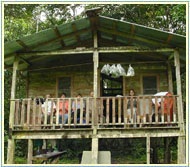A Day in the Caterpillar Nursery
Each day we meet after breakfast to divide into smaller teams. One or two teams will usually head off into a different part of the forest to look for caterpillars. Another team will go to the "zoo."
This job entails taking care of the caterpillars we have collected. We give each caterpillar a number and note carefully the data from the field on the lab sheets. The caterpillar is then kept in a clean separate plastic bag with several leaves from its host plant. New kinds of caterpillars are carefully photographed.
 |
 |
 |

Our lab and "zoo" out in the forest.
|
 |
 |
 |
The caterpillars are reared in a small lab out in the forest. This lab was once home to a farmer and is located near the river in a small clearing. The house is raised on stilts. The bags hang on ropes stretched across in the shade underneath the house.
The zoo team needs to check each caterpillar each day. Caterpillars that have pupated, or made their cocoons, are moved to a separate section. Here they are watched each day until the adult butterfly or moth appears. Since so little is known about many of these species, we sometimes don't know what the adult form of the caterpillar will be until it appears! Pictures are also taken of the adult butterflies and moths so that there is a record of both the adult and juvenile forms of each species. The pictures and information about the butterflies and moths of La Selva are eventually entered into an online database.
The rest of the caterpillars need to be fed and their bags cleaned when they get dirty. Even though there are over 1,800 species of plants in the reserve many caterpillars will eat only one certain type. This means that someone has to go "shopping" for the particular plants to find fresh leaves. Some of us are slowly learning how to identify these plants. One of the easiest is the Piper family because they have swollen places along their stems and long skinny flowers. The black pepper that you use to spice your food from this family of plants!
Photos courtesy of Shauneen Giudice/Earthwatch Institute

